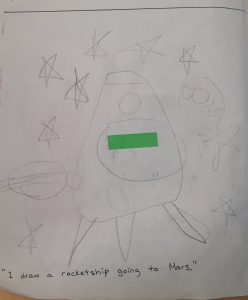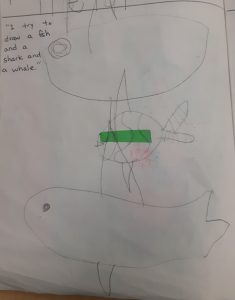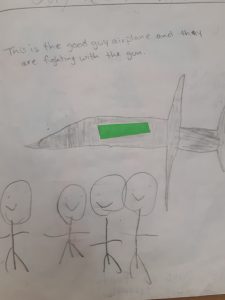For this lesson I hoped to use a story in a different way than the students had previously experienced. As part of a class at UBC we had done several exercises with the ‘into the story’ theme and found them very enjoyable and powerful, thus I decided to give it a try in a kindergarten classroom.
To begin, I had them stand up and pret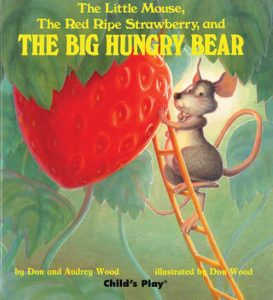 end to be little mice but when I opened the book to move the story forward most of them sat down. At this point it became clear that they were used to sitting while someone was reading a book, due to this I had the students sit throughout the rest of the lesson. Having them participate in some actions was fun; the actions were a mixture of ones I provided and ones they created. For example, I showed them how to hold their strawberry in one hand and cut it in half with the other but they showed me how they would guard their strawberry: some turned over and pretended it was under them, some put it in their pocket, some placed it behind themselves. Some parts became a verbal exercise over the actions as well – when asked how they would disguise their strawberry it was easier to share what they would do (these were answers like hide it under a blanket and use a ‘shinkerator’ on it, put it in a spiderman costume, and put in it a tomato costume to trick the bear). Integrating myself into the book resulted in the students giving me interesting looks. Every time the book mentioned the bear sniffing for strawberries I took on this role, some found it amusing while others looked a little confused as to if they were supposed to copy this action or just view it.
end to be little mice but when I opened the book to move the story forward most of them sat down. At this point it became clear that they were used to sitting while someone was reading a book, due to this I had the students sit throughout the rest of the lesson. Having them participate in some actions was fun; the actions were a mixture of ones I provided and ones they created. For example, I showed them how to hold their strawberry in one hand and cut it in half with the other but they showed me how they would guard their strawberry: some turned over and pretended it was under them, some put it in their pocket, some placed it behind themselves. Some parts became a verbal exercise over the actions as well – when asked how they would disguise their strawberry it was easier to share what they would do (these were answers like hide it under a blanket and use a ‘shinkerator’ on it, put it in a spiderman costume, and put in it a tomato costume to trick the bear). Integrating myself into the book resulted in the students giving me interesting looks. Every time the book mentioned the bear sniffing for strawberries I took on this role, some found it amusing while others looked a little confused as to if they were supposed to copy this action or just view it.
At the end I had them review some of the actions we did throughout the story to emphasize that it was different from how they are usually read stories. I used the word ‘drama’ a couple times but the new term seemed to be unnecessary to introduce to them considering it was their first time participating in a story like this. For next time I think it would be better to begin to read the book, like their routine, and ask them to participate in actions as we move through the book. Overall, it seemed enjoyable, and I would do it again.





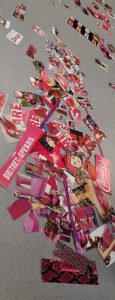
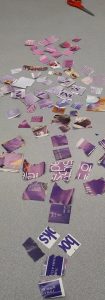

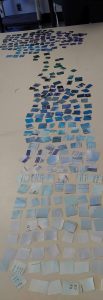
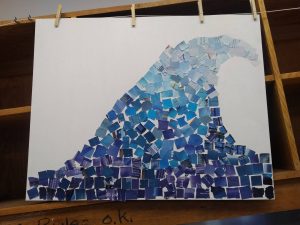


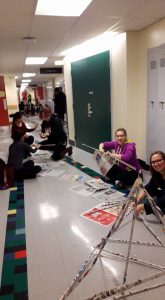


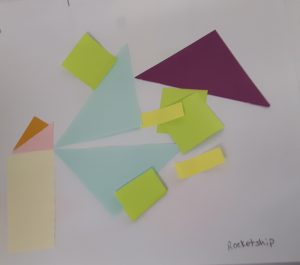
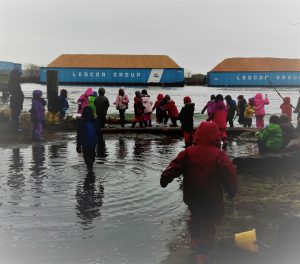


 For Remembrance Day students collected sticks, painted them, and an SA assembled them into a wreath. The kids enjoyed painting the sticks and the finished product, but the concept of Remembrance Day was difficult for many of them to grasp. On the other end of this, there was one girl who was crying as someone in her family had been in a previous war. A previous writing book activity that asked the kids to draw something they were thankful for had mixed results. Many could come up with something they were thankful for but naturally these were personalized selections including parents, siblings and material belongings/activities (for example birthdays or presents).
For Remembrance Day students collected sticks, painted them, and an SA assembled them into a wreath. The kids enjoyed painting the sticks and the finished product, but the concept of Remembrance Day was difficult for many of them to grasp. On the other end of this, there was one girl who was crying as someone in her family had been in a previous war. A previous writing book activity that asked the kids to draw something they were thankful for had mixed results. Many could come up with something they were thankful for but naturally these were personalized selections including parents, siblings and material belongings/activities (for example birthdays or presents).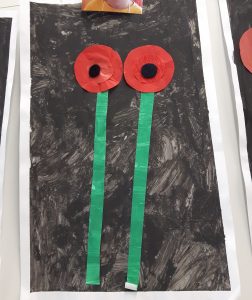 They could place one to three poppies on their black backgrounds (one student did four) with the poppies having a big red circle with a small red circle and a black center. The green stems were all the same material but the red circles were either tissue paper or crêpe paper and the black centers were buttons or velcro stickers. This activity showed how much prep can be involved in some art activities: the red circles were cut out in advance, the stems were cut in advance, and the black centers were purchased in advance.
They could place one to three poppies on their black backgrounds (one student did four) with the poppies having a big red circle with a small red circle and a black center. The green stems were all the same material but the red circles were either tissue paper or crêpe paper and the black centers were buttons or velcro stickers. This activity showed how much prep can be involved in some art activities: the red circles were cut out in advance, the stems were cut in advance, and the black centers were purchased in advance.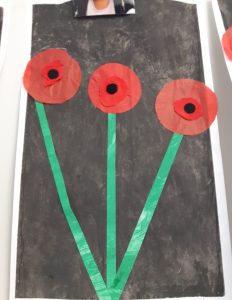 The results are appealing to the eye, and nicely decorated part of the gymnasium for the Remembrance Day assembly, but made evident the different types of art in the kindergarten classroom. This activity had an obvious outcome in mind and was presented to the children as such. I am curious what would have been the outcome if the children were given a little more free range on their poppy art. Despite the structure of the activity, the children still enjoyed completing this art project.
The results are appealing to the eye, and nicely decorated part of the gymnasium for the Remembrance Day assembly, but made evident the different types of art in the kindergarten classroom. This activity had an obvious outcome in mind and was presented to the children as such. I am curious what would have been the outcome if the children were given a little more free range on their poppy art. Despite the structure of the activity, the children still enjoyed completing this art project.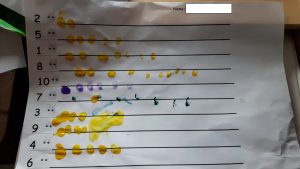 involved students using finger paint to make a designated amount of dots. There was a range of results the two below being one developing and one mastering.
involved students using finger paint to make a designated amount of dots. There was a range of results the two below being one developing and one mastering.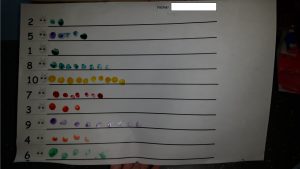 number and caterpillar face underlined as well as the area where I expected their finger prints to go. It also may have been helpful if I hung the example I modeled so that students could glance at it as a reference (I left it laying flat to dry). Being that this lesson was the one that my School Adviser was observing, he did not help manage the students, due to this I quickly learned how difficult it is to monitor 22 kindergartners. This also made me see how it may benefit a teacher to be seated or standing in one area that allows them to see the whole classroom. Circulating throughout the room meant my back was turned to students several times which meant that I didn’t always see students misbehaving.
number and caterpillar face underlined as well as the area where I expected their finger prints to go. It also may have been helpful if I hung the example I modeled so that students could glance at it as a reference (I left it laying flat to dry). Being that this lesson was the one that my School Adviser was observing, he did not help manage the students, due to this I quickly learned how difficult it is to monitor 22 kindergartners. This also made me see how it may benefit a teacher to be seated or standing in one area that allows them to see the whole classroom. Circulating throughout the room meant my back was turned to students several times which meant that I didn’t always see students misbehaving. version. It was a read-aloud lesson which began with the book The Way of the Ninja and is a story about friendship. The book depicts the Ninja playing alone, due to careless actions, and with friends once he realized his mistake.
version. It was a read-aloud lesson which began with the book The Way of the Ninja and is a story about friendship. The book depicts the Ninja playing alone, due to careless actions, and with friends once he realized his mistake.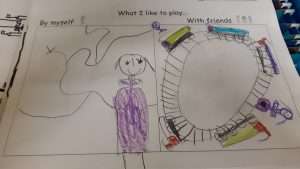
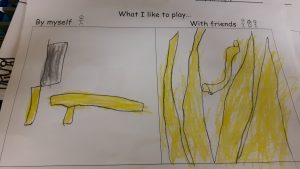

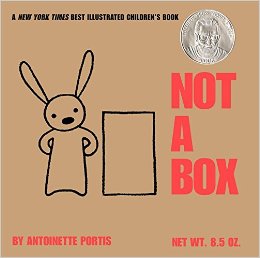 The lesson was a writing lesson, which at this point is a drawing and a corresponding sentence created by the student but written by the teacher.
The lesson was a writing lesson, which at this point is a drawing and a corresponding sentence created by the student but written by the teacher.